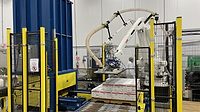Market Research
Fact.MR Reports Food Robotics Market to Skyrocket

Image courtesy of Bunting-Newton
Fact.MR reports increased automation and advanced technology will skyrocket food robotics market and reach a valuation of $7.8 billion by 2033.
The global food robotics market is estimated at $2.47 billion in 2023, according to a study conducted by Fact.MR, a market research and competitive intelligence service provider. Worldwide demand for food robotics is projected to rise at a CAGR of 12% and reach a market value of $7.8 billion by the end of the forecast period (2023 to 2033).
- Global labor scarcity in the agriculture and food processing sectors is one of the key factors driving the adoption of food robotics. Autonomous robots become necessary to sustain output levels as the workforce ages and new generations are less willing to seek jobs in these industries.
- The transformation of the food and beverages sector with the integration of automated technologies and rising demand for high-quality and ready-to-eat meals is driving the growth of the food robotics solution.
- Robotics can provide the precision and dependability required to achieve stringent quality control standards, lowering the risk of contamination and recall.
What is Driving the Digital Revolution in the Food Industry?
Several significant factors have contributed to an increase in demand for packaged goods in the food robotics sector. For starters, changing consumer habits and preferences have resulted in a greater reliance on ready-to-eat and pre-packaged food products. The COVID-19 pandemic has hastened the demand for automation and contactless processes in food production and packaging since cleanliness and safety have become top priorities.
A combination of factors contributes to improved food safety and quality, which is a driving force for the use of food robotics. Robots that are developed with hygiene and contamination control to provide consistent and accurate handling of food products, reducing the possibility of errors and enforcing rigorous quality standards. Sensors and cameras offer real-time monitoring and quality control, allowing for prompt detection and action in cases of flaws or anomalies during processing.
What is Holding Back Food Robotics from Gaining Traction in the Market?
Lack of a skilled workforce is a significant barrier to the growth of the food robotics market. Food robot systems require specialized technical expertise, such as programming, troubleshooting, and in-depth knowledge of mechatronics and electrical engineering, to operate, maintain and optimize.
How can Startups Establish Their Presence in the Market?
With a shortage of experienced and cost-effective labor, the food sector is resorting to automated food production technologies to attain higher precision and yields. This trend is propelling the food robotics sector forward and opens up a world of opportunities in the food robotics industry for leaders to develop and revolutionize the market.
What Makes China a Growing Hub for Food Robotic Solutions?
Several significant elements are driving China's rise as a growth hub in food robotics solutions. China’s diverse food industry provides fertile ground for automation adoption, particularly as labor prices rise. Government assistance, regulatory incentives and a commitment to technical innovation all contribute to this expansion.
Is India Set to Emerge as a Lucrative Market for Providers of Food Robotic Solutions?
The food industry in India is expanding rapidly, propelled by a growing population, urbanization and shifting customer preferences, offering an excellent setting for automation in food production, processing and packaging. India is also concerned with less labor availability and rising labor costs, making automation essential for preserving cost efficiency and competitiveness.
Why is Palletizing a Key Segment in the Food Robotics Market?
The palletizing and processing segments held a dominant share of the market in 2022. Palletizing refers to the automated arrangement and stacking of food products, packaging materials, or containers onto pallets systematically and efficiently. Food robotics systems are outfitted with specialized end-of-arm tools (EOATs) that allow for exact product arrangement and stacking. This procedure improves food packing efficiency, precision and consistency while lowering labor costs and reducing the chance of errors or damage.
Competitive Landscape:
- Mitsubishi Electric Corporation launched a teaching-less robot system technology built primarily for food processing facilities in February 2022. Without supervision, these robots carry out organization, sorting and other comparable operations at the speed of humans.
- Rockwell Automation Inc. announced a relationship with Comau in April 2021. The goal of this collaboration was to simplify processing and lifecycle management in the food and beverages industry.
Looking for a reprint of this article?
From high-res PDFs to custom plaques, order your copy today!







